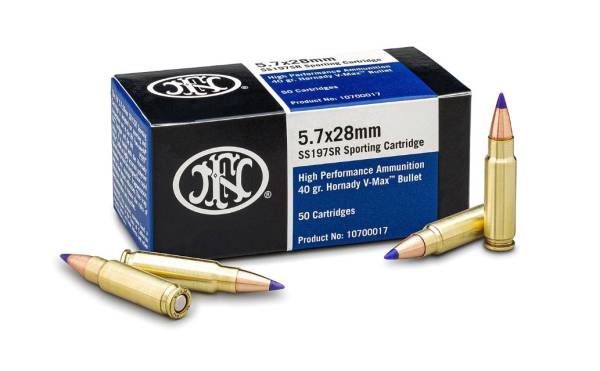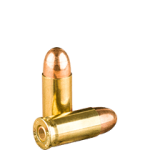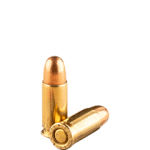Description
The .357 SIG cartridge was introduced in 1994, as a combination of efforts from the Swiss-German company SIG SAUER and the American munitions manufacturing company Federal Premium Ammunitions. With a rimless, bottlenecked case, the .357 SIG was made to mimic the velocity and stopping power of the .357 Magnum, but was designed to be fired from a semi-automatic pistol.
While the original bullet size was .357 inch, it was quickly phased down to .355 inch for ease of use. It was the first bottleneck commercial handgun cartridge since the early 1960s, with the standard form of the ammunition featuring a bullet weighing in at 125 grain (gr), the same average weight of a .357 Mag bullet. This bullet reaches an average velocity of 1,350 feet per second (fps) and a muzzle energy of over 500 foot pound force (ft·lbs), making it easily comparable to the standard .357 Magnum ammunition.
Although many internet sources say the .357 SIG casing is a sized-down .40 S&W case, that’s not quite accurate. The case of the .357 SIG is slightly longer (.009 inch) than the .40 S&W and thicker throughout, making it more similar to a necked down 10mm.
Development of the .357 SIG
When SIG SAUER introduced the .357 SIG in 1994, the company’s goal was to develop a cartridge with the power of the .357 Magnum, but also with the ability to be used specifically in semi-auto pistols. The ammo was released just four years after the .40 S&W, which was created after the FBI requested a new caliber with the stopping power of the .45 ACP and the ease of the 9mm parabellum. While the .40 S&W cartridge has its pros and cons, it had an instant market as local and federal law enforcement ammo.
The .357 SIG, on the other hand, was a whim between two companies. And while the round is both accurate and reliable, the market wasn’t quite ready for two new semi-automatic pistol calibers, especially two so similar in size and function. Those who’ve shot the .357 SIG love it and have fun training with it, but as a whole, the cartridge hasn’t gained as much popularity as the .40 S&W – even though it has a good reputation (better than the .40 S&W) and performance history.
What’s it Like Shooting the .357 SIG?
The .357 SIG is an exceptionally effective round. It’s accurate, powerful, and easy to shoot – with a bullet that has a high velocity and an unusually flat trajectory for a semi-automatic ammunition. Because of this trajectory, it’s accurate at an extended range, especially when compared to similar sized firearms chambered to other calibers.
Another benefit of the .357 SIG is that the design permits the cartridge to be fired from a .40 S&W pistol just by changing the barrel. This adds a great advantage of not having to purchase multiple firearms to shoot different calibers.
The recoil of the .357 SIG cartridge is comparable to the .40 S&W, is significantly less than the .357 Magnum, and is an easier round to handle according to many shooters. When comparing the velocities, energy, and handleability of cartridges – ranging from the 9mm to the .45 ACP – nothing can match the .357 SIG.
What’s more, because of its unique design among other semi-automatic calibers, the .357 SIG feeds well and rarely, if ever, has an issue loading into a firearm.
Uses for the .357 SIG
The 125 gr .357 Magnum bullet that the .357 SIG is modeled after is a self-defense round with years of proven effectiveness. It has routinely been issued by police agencies for their service revolvers, although the growing popularity of 9mm and .40 S&W (and semi-automatic pistols in general) gradually pushed revolvers, including the .357 Magnum, out of law enforcement circles.
While the .357 SIG is not the most popular law enforcement handgun cartridge, it has been issued by several prominent police agencies as their sidearm cartridge. The first major law enforcement agency to issue the .357 SIG for duty was the Texas Highway Patrol in 1995. Many federal agencies, including the Secret Service, Bureau of Industry and Security and Air Marshals, all continue to use the .357 SIG today.
Many state law enforcement agencies use or have used .357 SIG ammo as their duty pistols, including: Delaware, Mississippi, Montana, New Mexico, North Carolina, Oklahoma, Rhode Island, Tennessee, Texas, and Virginia. Many other county and city-level agencies have also adopted the .357 SIG – with most using SIG SAUER or Glock pistols.
It makes sense, then, that the .357 SIG is popular as a self-defense round. It has immense stopping power and more than reliable accuracy. For those who are proponents of hydrostatic shock, most .357 SIG ammunitions are strong enough to create such a phenomenon, leading to more stopping power and lethality.
What Are the Different Types of .357 SIG Ammunition?
Because different shooters have different needs, the .357 SIG comes in various types of bullets and rounds. Some of the most available .357 SIG ammunition can be found in the following forms:
Full metal jacket (FMJ): FMJ ammo features a lead bullet encased in a harder metal, often copper. This allows the bullet to hold its shape as it propels toward its target. Because this type of bullet doesn’t expand like self-defense rounds, it’s used as the top choice for .357 SIG practice ammo. When buying bulk .357 SIG ammo, this is often the most readily available type of ammunition.
Jacketed hollow point (JHP): JHP ammo also has a lead bullet covered in a harder metal, but with this round, the bullet has a hollow point leading to the bullet’s center. This helps the lead expand on impact, creating a larger wound and greater stopping power. It also stops over-penetration and is therefore typically seen in the firearms of law enforcement. It’s also common as a self-defense round.
Full metal jacket – flat point (FMJ-FP): The FMJ-FP ammo has a full metal jacketed bullet, but with a flat point at the end of the projectile (unlike the rounded tip seen in 9mm and .40 S&W). These bullets are often used in target shooting because they leave crisp holes in paper, almost like they cut through it instead of rip. They’re also more effective as a self-defense round than FMJ ammo.
Total metal jacket (TMJ): While the FMJ bullet is encased in metal, the whole bullet is not – inside the cartridge casing, a part of the lead ball is exposed. In TMJ bullets, the entire projectile is covered in copper or another hard metal. This limits lead exposure, which is why these bullets are required at some indoor gun ranges.
.40 S&W vs. .357 SIG
When comparing the .40 S&W to the .357 SIG, the results are similar but tend to favor the newer, smaller cartridge. Both rounds are rimless casings, housing decent sized bullets (the .40 is about 1mm larger than the .357 SIG) that threaten with significant damage. The casing of the .357 SIG is both thicker and longer than the .40 S&W (when comparing the .40 vs. .357 SIG, the casing lengths differ by .005 inches) and more resembles the 10mm casing.
The ammunitions share the same rifling twist (one in 16 inches) and primer type (small pistol), but differ when it comes to maximum pressure. According to the Sporting Arms and Ammunition Manufacturers Institute (SAAMI), the maximum pressure of the .40 S&W is 35,000 psi, while the .357 SIG is 40,000 psi (C.I.P. rates the max pressure for the .357 SIG at 44,240 psi).In its standard form, the .40 S&W shoots a 165 gr bullet at a velocity of 1,130 fps with 468 ft·lbs. In the .357 SIG, the standard round has a 125 gr bullet traveling at 1,350 fps with 506 ft·lbs. This shows that the.357 SIG meets the goal of traveling faster and hitting harder than the .40 S&W, even with the lighter bullet.
What makes the comparison between these two calibers unique is the fact that most semi-automatic pistols chambered for the .40 S&W can shoot a .357 SIG cartridge with a simple barrel change. Although it’s not always necessary, you may also need to replace the recoil spring after a period of use. The weaker spring can last for awhile, but because the .357 SIG is loaded to a higher pressure than the .40 S&W, it can wear out the weaker ammo’s spring.
The magazines between the two different ammunitions are mostly interchangeable, and with the .357 SIG’s bottleneck design, it feeds easily and jams are unlikely.
When it comes to pricing, the .40 S&W tends to be less expensive than the .357 SIG. Yet if you purchase .357 SIG ammo, bulk prices are cheaper than buying one box at time, making it more affordable.
.357 Magnum vs. .357 SIG
While the .357 SIG is modeled after the .357 Mag, there’s significantly more data on the Magnum cartridge than the SIG, especially in defensive shooting situations. Yet when looking at the ballistics details between the two cartridges, it’s evident that the .357 SIG is just as capable as the .357 Magnum.
The .357 Magnum has a larger bullet (by .002 inch), a rimmed cartridge, and a thicker casing (by .005 inch) – making its performance similar to the .357 SIG. When comparing full metal jacket ammo with a 125 gr bullet, the .357 Mag has a velocity of 1,450 fps and an energy force of 583 ft·lbs. The .357 SIG 125 gr bullet has a velocity of 1,350 fps and an energy force of 506 ft·lbs. But if you flatten the tip of the bullet, as is common in the .357 SIG, these ballistics improve and match those of the Magnum cartridge, with the weight of a 125 gr bullet reaching the velocity of 1,450 fps and an energy force of 583 ft·lbs.
These results occur because the semi-automatic pistol cartridges are under a higher pressure than the Magnum cartridge. While the revolver round uses a magnum primer, it’s only pressured to a maximum of 35,000 psi, while the .357 SIG can reach 40,000 psi, according to SAAMI.
It’s clear that these ammunitions share performance specifications, but once the .357 SIG bullet reaches a weight over 125 gr, it loses power and its performance starts to slack. While it’s still completely capable at 135 and 145 gr, it can no longer compare to the .357 Magnum’s speed or impact.
Popular Names for the .357 SIG
Like many common ammunition calibers, the .357 SIG is known by different names in different circles. This particular ammo is referred to as both the .357 SIG and the .357 Sig. SAAMI, which sets the industry standard in ammunition, uses the uppercase .357 SIG, while the Permanent International Commission for Firearms Testing, commonly referred to as C.I.P., uses .357 Sig.
Sometimes the round is seen written as its size: 9x22mm. Like the above uses, this is a correct way to reference the ammunition and acceptable in most circles.
But sometimes, the ammunition’s name is presented in an incorrect way. The most frequent mistake is written as “357 Sig ammo” without the decimal point. Since the decimal point signifies that the bullet measures .357 inches, this makes it grammatically incorrect, even though the meaning is not lost.
Popular .357 SIG Firearms
Manufacturers with firearms chambered for the .357 SIG are limited. SIG SAUER, Glock, and Smith & Wesson have all issued semi-automatic handguns for the .357 SIG, although Smith & Wesson has discontinued production within the last decade.
SIG SAUER, the company that originated the .357 SIG ammunition, offers multiple handguns chambered for the round. According to the company, the P226 is the combat pistol all others are compared to. A full-sized handgun, it comes with either a 10- or 12-round magazine. The P229 is a compact .357 SIG semi-automatic designed for law enforcement. It features night sites and a 10-round magazine. Designed for concealed carry, the P320 comes with a 10- or 14-round magazine and a stainless steel construction. SIG also offers a traditional 1911 chambered in .357 SIG with a stainless steel body and skeletonized trigger, allowing for rapid firing.
Glock manufactures three different semi-automatic handguns chambered for .357 SIG ammo. The G31 is a full-sized handgun that features a 15+1 magazine. The compact G32 offers the same reliability and accuracy that’s expected of a Glock, but in a smaller package. Its magazine holds 13 rounds. The G33 is an easy-to-conceal subcompact with a 9+1 carry capacity.
Although they’re no longer made, Smith & Wesson made a .357 SIG pistol in their M&P line. Keep an eye out in used gun stores, as this firearm is a favorite of most everyone who’s been lucky enough to shoot one, let alone get their hands on one for purchase.
Regardless if you like to plink at the shooting range or are looking for a self-defense concealed carry pistol that has amazing stopping power, you can find it with .357 SIG ammo. While the firearm options are limited, every manufacturer that makes a semi-automatic pistol chambered for the .357 SIG provides a weapon that’s reliable, accurate, and solid in your hand.
FAQ
What is .357 SIG Ammo?
The .357 SIG cartridge is the result of a joint effort between SIG SAUER and Federal Ammunition. The round was designed to mimic the velocity and stopping power of the .357 Magnum, but was intended to be fired from a semi-automatic pistol.
Which is the best .357 SIG round for self-defense?
All .357 SIG rounds have massive stopping power, but some are better for self defense purposes. While full metal jacket (FMJ) ammo is easy to come by, its expansion on impact is minimal and it’s high risk for over penetration. Instead, opt for a FMJ-Flat Point or jacketed hollow point (JHP), which offer better ballistics for self defense situations.
What is the most accurate .357 SIG ammo?
Most manufactured .357 SIG cartridges are accurate, as the round itself is highly accurate with a long trajectory. This trajectory makes it more accurate at a distance when compared to other similar-sized semi-automatic cartridges like the 10mm or .40 S&W. Opt for a quality ammunition company such as Federal, Winchester, or Hornady.
What guns are chambered for .357 SIG ammo?
SIG SAUER, Glock, and Smith & Wesson have all manufactured pistols chambered in .357 SIG, although Smith & Wesson has discontinued production on its model. Two of the most popular models include the SIG SAUER P229 and the Glock G31, although both manufacturers offer variations, including a SIG SAUER 1911 chambered in .357 SIG.
How much does .357 SIG ammo cost?
When it comes to ammo prices, .357 SIG rounds are not cheap. Because the round is not overly popular, it costs more than similar sized cartridges. For instance, the average starting price per round of .357 SIG is $0.35, while the starting price per round of 45 ACP is $0.25 and $0.265 for .357 Magnum ammo. Purchase bulk ammo to get the best deal.
What is the difference between .357 SIG ammo and .357 Mag ammo?
Although they look different in size and shape, the .357 SIG and the .357 Mag share a similar ballistic performance. When shooting full metal jacket (FMJ) rounds with 125 grain bullets, the .357 Mag slightly out-does the .357 SIG. But if you flatten the projectile’s tip and opt for FMJ-Flat Point rounds, as is common in the .357 SIG, it increases the semi-auto round’s velocity and muzzle energy to match that of the .357 Mag at 1,450 feet per second and 583 foot pound energy.





